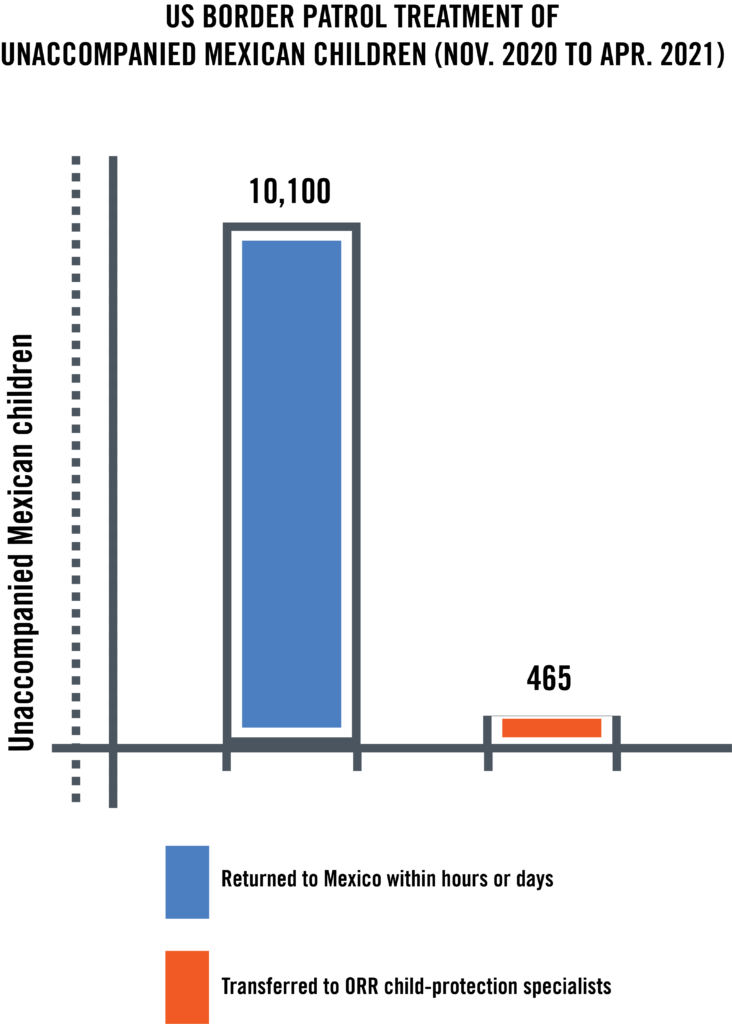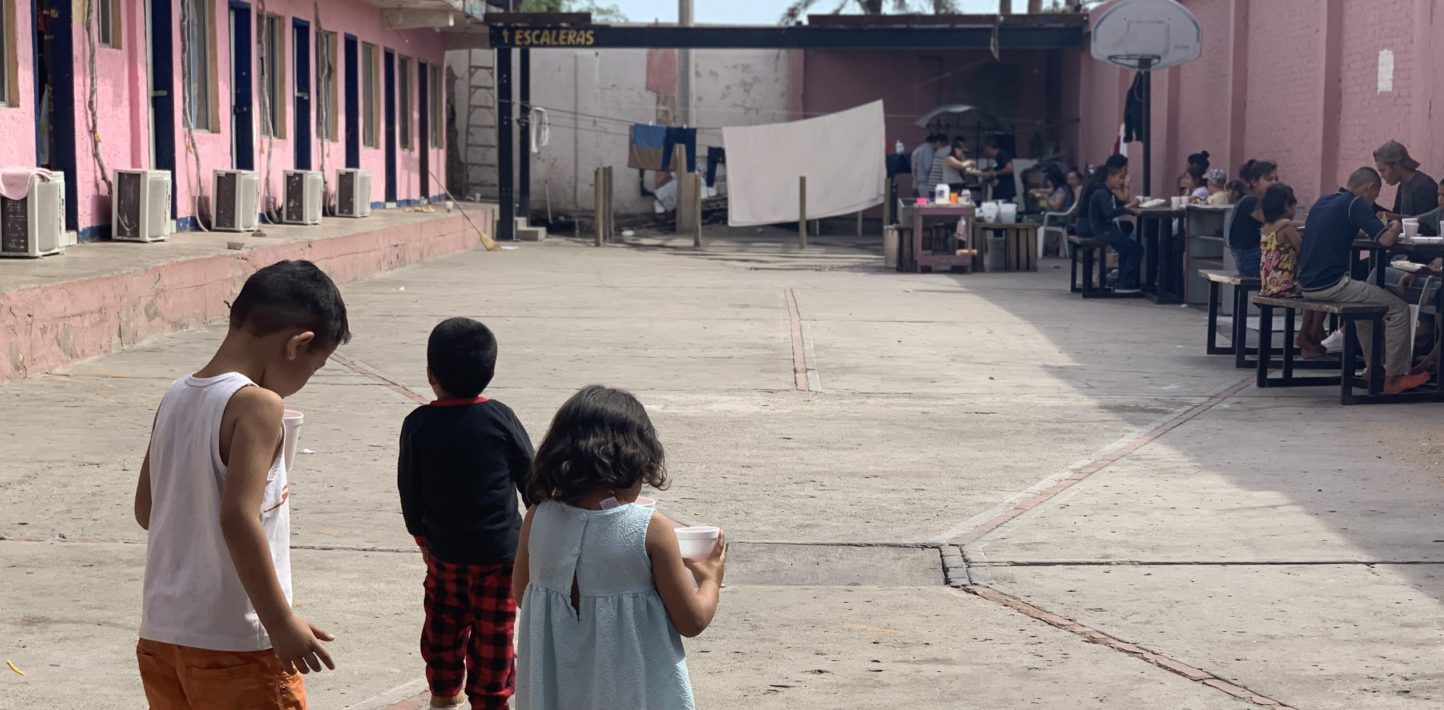Regional trends regarding unaccompanied children migrating and seeking asylum in the USA and Mexico:
- According to the United Nations Children’s Fund (UNICEF):
- According to UNICEF and the UN refugee agency (UNHCR):
- According to the US Department of Homeland Security (DHS):
US government statistics on returns of unaccompanied Mexican children to Mexico
- The DHS border agency Customs and Border Protection (CBP) has two main components, both of which process unaccompanied migrant children:
- From March to November 2020, DHS apprehended and summarily expelled at least 13,000 unaccompanied migrant children based on a public health order under Title 42 of the US Code.

- From November 2020 to April 2021 (after Title 42 stopped being applied to unaccompanied children), about 20 percent of the nearly 60,000 unaccompanied migrant children apprehended by the US Border Patrol were Mexican nationals.
- CBP is misusing a provision of an anti-trafficking law called the Trafficking Victims Protection Reauthorization Act (TVPRA) to summarily return the vast majority of unaccompanied Mexican children to Mexico (under so-called “voluntary returns”), after inadequately screening them for protection needs or risk of harm, and thereby denying them access to asylum procedures.
- Under that law, CBP officials are legally required to screen unaccompanied Mexican children, or instead route them to child protection specialists in ORR.
- According to academic researchers, CBP has failed to effectively screen about half (50%) of unaccompanied Mexican migrant children prior to returning them over the border to identify: (1) if they feared return to Mexico; and (2) if they were victims of human trafficking. More than half of children also reported they had no idea they were signing forms consenting to their returns to Mexico, and CBP didn’t explain it – in some cases even pressuring children to sign the forms they did not comprehend.
- The UN refugee agency (UNHCR) found that a 46 percent of unaccompanied Mexican children interviewed in Border Patrol custody prior to being returned to Mexico identified needs for international protection. Threats they often faced ranged from inescapable violence in their home states (32 percent), to exploitation by human smugglers (50 percent), to violence directed at them by Mexican armed forces (10 percent).
- From 2014 to 2019, DHS reported that it swiftly returned 88% of a total of 79,055 unaccompanied Mexican children under that legal provision.
- On 25 May 2021, CBP informed Amnesty International that it had returned approximately 10,270 unaccompanied Mexican children from November 2020 to April 2021 under the TVPRA “voluntary returns” provision. In contrast, CBP referred only a few hundred unaccompanied Mexican children to child protection specialists at the US Department of Health and Human Services (HHS) Office of Refugee Resettlement (ORR) during the same period.
- In total, the US Border Patrol returned 95% of unaccompanied Mexican children to Mexico after apprehending them when they crossed the US–Mexico border (10,100) – more than 22 times as often as they transferred the children to ORR to initiate immigration or asylum cases (465).
- In contrast, when unaccompanied children were allowed to present themselves at ports-of-entry during that period, CBP recorded roughly equal numbers whom CBP’s OFO component returned to Mexico (171) and referred to ORR (173) – possibly reflecting that those few hundred unaccompanied Mexican children who were able to access ports-of-entry were more likely to have legal representatives supporting them, improving their chances of being received and routed to protection services.
- According to the Mexican government, US border authorities conducted at least 8,632 repatriations of unaccompanied Mexican children from November 2020 to April 2021. This number is about 15 percent lower than the 10,271 returns reported by CBP (not including Title 42 expulsions). Either way, those statistics confirm that CBP has returned the vast majority of Mexican unaccompanied migrant children to Mexico, even after they were exempted from Title 42.
- According to statistics shared with Amnesty International by Mexican authorities, CBP returned 750 unaccompanied Mexican children just to the city of Juarez from 1 January to 7 May 2021. This compared to 744 in all of 2020, and 1,283 in all of 2019.
Mexican government statistics on returns of unaccompanied Central American children to their countries of origin
- In 2019, Mexican immigration authorities returned more than 90 percent of the unaccompanied Central American children they encountered, almost 12,000 children in total.
- In 2020, despite reduced migration during the COVID-19 pandemic, Mexican authorities still forcibly returned over 3,300 unaccompanied migrant children to Central America, more than 70 percent of those whom they took into custody.
- So far in 2021, Mexican authorities have reported deporting about half of the unaccompanied Central American migrant children whom they have taken into custody nationwide. With the shelters of Mexico’s child protection authorities (DIF) overcrowded, and processing times delayed, it is likely those rates of return will climb steeply in the second half of 2021.
- Amnesty International received information from DIF in Juarez that the rates of repatriation of Central American children were as high as 85 percent in some localities in the first quarter of 2021.
- According to DIF in Juarez, the average length of time children spent in shelters went from approximately 15 days in 2020, to an average of four months in 2021.
- The Mexican Commission for Refugee Assistance (COMAR) reported receiving about 30 percent more asylum requests in the first quarter of 2021 compared to the same period in 2020.
- According to the Mexican government, the National Migration Institute (INM) processed 70,787 unaccompanied migrant children from 2015 to August 2020, and returned most of them to their countries of origin.
- In December 2020, UNHCR and UNICEF reported the following common characteristics of unaccompanied migrant children whom they interviewed in El Salvador, Guatemala, Honduras, and Mexico:


